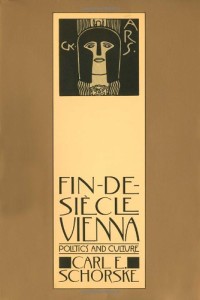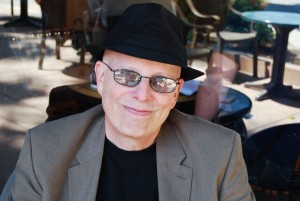Classics Series
Carl E. Schorske. Fin-de-Siècle Vienna (New York: Random House,1979)
Review by George Cotkin
Sometimes you can judge a book by its cover. Such was the case with Carl E. Schorske’s Fin-de-Siècle, published in 1980. The cover featured a lush gold-colored background, with a vertical rectangular form imposed on it that looked like a bookmark or bookplate. At its top was a Gustav Klimt illustration, which had appeared in the first issue of the Austrian secessionist magazine Vera Sacrum in 1898. Below this image of a helmeted woman with some demon’s head just below her neck, was blank space, allowing perfect balance for the title and author’s name at the bottom. The typeface, of course, suggested the secessionist style. Opening the volume yielded additional delights, with many black and white images interspersed within the text, as well as two sections resplendent with color plates. This feast for the eyes would quickly translate into munificence for the mind.
The book had been a long-time coming. Three of its essays had already appeared in The American Historical Review – the first one in 1961, with the others in 1967 and 1973. Another piece, “Politics in a New Key: An Austrian Triptych” had been published in 1967 in The Journal of Modern History. In those digitally-deprived days, one struggled to stretch tightly-bound volumes of those journals so that two-pages per shot might be obtained,  without the loss of print from the inner and outer edges. The completed copies were treasured, read and reread, annotated with care. Their hieratic status ended quickly once the book appeared.
without the loss of print from the inner and outer edges. The completed copies were treasured, read and reread, annotated with care. Their hieratic status ended quickly once the book appeared.
Fin-de-Siècle consisted of these four essays, along with three new ones. [1] The book was a model of intellectual and cultural history, albeit a dangerous one. It was intimidating for a neophyte historian thanks to Schorske’s stylistic elegance, formal vision, and daunting knowledge. When I first got hold of the volume, I was in the process of transitioning from a labor historian (but with a dissertation on working-class intellectuals and evolutionary thought that hinted at such an inclination) to an intellectual historian. This movement had gone into overdrive thanks to a six-week National Endowment for the Humanities/American Studies Association summer seminar at Haverford with the meaty title, “The Newtonian and Darwinian Revolutions in American Thought.” Lecturers for the seminar included Bruce Kuklick, David Hollinger, Sacvan Bercovitch and other luminaries. Many of the participants would go on to distinguished careers in intellectual and cultural history. Schorske, in a manner of speaking, was to be my Virgil in navigating this new world.
Each of the essays in Fin-de-Siècle placed a figure (or figures) in the fulcrum of political changes, as per the volume’s subtitle, “Politics and Culture.” Schorske’s essential thesis was that the relatively short-lived heyday of Austrian liberalism, initiated in the 1860s, had by the 1880s unleashed forces (modernization, mass politics, and anti-Semitism) that would destroy liberal ideals of reason and order. The sons of these liberals would challenge these beliefs, as well. A new generation, in thought and art, would embrace fervently the instincts, passions, and the irrational. A focus on politics and social cohesion was replaced by a retreat into the self. This shift resulted in art that was inspired but narcissistically narrow, often devoid of political valence.
In the Introduction, and in a later essay, Schorske made clear the context for his study. [2] A committed liberal activist, Schorske had begun writing about his subject while the shadow of the Red Scare still darkened the hallways of the University of California, Berkeley, where he was teaching, in the form of limits to speech and loyalty oaths. Many postwar intellectuals, reared on leftist politics in the 1930s, had by this time turned to Freud as a political guru: utopian aspirations were a sign of adolescent immaturity, in their stead was preferred a tragic sensibility predicated on limitations, political and personal. The book could be an implicit critique of this turn to the self and away from politics, as well as being against the angst-ridden, politically-neutered art of abstract expressionists and the soundings of existentialists. Secession redivivus. Although the name of Hitler surfaced but a handful of times in Fin-de-Siècle, his presence, with its odor of chaos and destruction, was anticipated on almost every page – and as a warning about the Cold War infused politics of the present.
By the time the book appeared in print, its political message might also have resonated in a different manner. The politics of protest in the 1960s had, in the view of some, taken a wrong turn, perhaps akin to what had happened in Vienna. Political revolt had not only been coopted but disarmed by a fascination with the forces of the irrational (with entry into them aided by drugs) and chaos. The grasping after personal freedom seemed to bring forth pipe dreams – that cultural fests such as Woodstock might see “the bombers jet planes riding shotgun in the sky/ turning into butterflies across our nation” – as Joni Mitchell imagined it. And as also imagined, on a different level by Herbert Marcuse and Norman O. Brown’s employment Freudian ideas as liberating sometimes along with the view of madness as sanity.
The dawning of the 1980s brought the hulking presence of postmodern theory into the hallways of the humanities, although history departments generally refused to open their doors to it. Schorske’s book eschewed theory for empirical fact but without naiveté. In the introduction to his book, Schorske had been forthright and reflexive about the imperatives that pushed his research agenda. He proudly occupied a middle-ground position. Along with scholars in the history of ideas and the new criticism, he respected the internal logic of texts, the form as much as the content. At the same time, he demonstrated that form and content should not be divorced from contexts, both political and biographical. Schorske not only wrote about Freud’s obvious centrality but employed Freudian psychology – the unconscious, dream interpretation, the Oedipal complex, sublimation, the family romance, and the instinctual – as tools for understanding Freud and his contemporaries in Vienna.
Space constraints prevent me from communicating the riches that unfolded within the covers of Fin-de-Siècle. The chapter on Klimt placed him right in the plaza of Viennese discontent, as his work lost favor with both liberals and reactionaries. He retreated into portrait painting as a sort of refuge where aesthetics replaced political commentary. Another chapter showed competing architectural visions and how they were realized and rejected in the Ringstrasse. Freud’s revolution in psychology was presented as a multi-faceted revolt against his father and the custodians of the academy in Vienna. In one chapter, Schorske daringly combined two leading anti-Semites, Georg von Schonerer and Karl Lueger alongside Zionist apostle Theodor Herzl! They shared common enemies and developed a new politics, based on emotional appeal and mass sentiment, however different the content of their messages. The final chapter on Oskar Kokoschka and Arnold Schoenberg indicated how explosive the new currents of thought could be, although in the case of the latter, there was an intense desire to create an order in art that was lacking in the world.
So, then, what lessons did an historian of American thought and culture gain from this book on Vienna? First, it helped me understand generational revolt and the relationship between political crisis and thought, and I tried to apply such ideas in my first book, William James, Public Philosopher (1990). While I would never be able to mimic Schorske’s elegant and sometimes epigrammatic style (“Aspiring to tragedy, Schnitzler achieved only sadness,”14) I was driven to pay ever-greater attention not only to the literary aspects of historical composition, but also to experiments with form. In Dive Deeper: Journeys with Moby-Dick (2012), my frustration with traditional historical narratives, gave birth to a book that was organized not in chronological order but with each chapter kept short, inspired by a feeling, a line, or perhaps the tone of a corresponding chapter in Moby-Dick. In my forthcoming book, Feast of Excess: A Cultural History of the New Sensibility, I go out on a limb anew. Each chapter deals with a single year, from 1952 to 1974, focusing on one or two characters at that moment that were creating an important work of what I characterize, following Susan Sontag and Tom Wolfe, as The New Sensibility. This disparate configuration of figures, from all walks of cultural creation, takes its inspiration, in part, from Schorske’s book. I don’t know if he would approve of my last two books with their rejection of traditional form; he might consider them too beholding to the excesses of Kokoschka and company. But I am forever in awe of Schorske’s book and return to it always with respect.
[1] Schorske, Fin-de-Siecle Vienna: Politics and Culture (New York: Alfred A. Knopf, 1980). The book would be awarded the 1981 Pulitzer Prize in Non-Fiction. While almost all historians were impressed with the book overall, many complained about specifics of his analysis, especially on Austrian liberalism and its demise. See, Michael S. Roth, “Modernist Contextualism in Carl Schorske’s Fin-de-Siecle Vienna,” The American Historical Review 99 (June, 1994), 729-745; Robert A. Kann, “Carl Schorske’s Fin-de-Siecle Vienna,” Central European History 14 (June, 1981), 169-181; John Boyer, “Review,” The Journal of Modern History 52 (Dec.,, 1980), 725-730. For a meta-critique, see Dominick Lacapra, “Is Everyone a Mentalité Case?: Transference and the ‘Culture’ Concept,” History and Theory 23 (Oct. 1984), esp., 302-306.
[2] Schorske, “The Author: Encountering History,” in Thinking with History: Explorations in the Passage to Modernism (Princeton: Princeton University Press, 1998), 17-34
George Cotkin taught in the History Department at Cal Poly for thirty-three years, retiring in 2013. He was a Fulbright Scholar at the University of Rome in 1994. He has published five books, most recently, Dive Deeper: Journeys with Moby-Dick
for thirty-three years, retiring in 2013. He was a Fulbright Scholar at the University of Rome in 1994. He has published five books, most recently, Dive Deeper: Journeys with Moby-Dick
(Oxford). His new book, Feast of Excess: A Cultural History of the New Sensibility
, will be published by Oxford University Press in December 2015. He is presently working on a book about Dashiell Hammett and Raymond Chandler.

2 Thoughts on this Post
S-USIH Comment Policy
We ask that those who participate in the discussions generated in the Comments section do so with the same decorum as they would in any other academic setting or context. Since the USIH bloggers write under our real names, we would prefer that our commenters also identify themselves by their real name. As our primary goal is to stimulate and engage in fruitful and productive discussion, ad hominem attacks (personal or professional), unnecessary insults, and/or mean-spiritedness have no place in the USIH Blog’s Comments section. Therefore, we reserve the right to remove any comments that contain any of the above and/or are not intended to further the discussion of the topic of the post. We welcome suggestions for corrections to any of our posts. As the official blog of the Society of US Intellectual History, we hope to foster a diverse community of scholars and readers who engage with one another in discussions of US intellectual history, broadly understood.
Thanks for this, George! I hadn’t read the book, but now I’d like to. So many books, so little time! – TL
I love this review and I love this series! It’s very enlightening to hear seasoned voices reflect on the works that shaped their initial forays into the field and from which they continue to draw inspiration. Maybe Wm. James was right: we are all of us, in the privacy of the self, hero-worshippers.